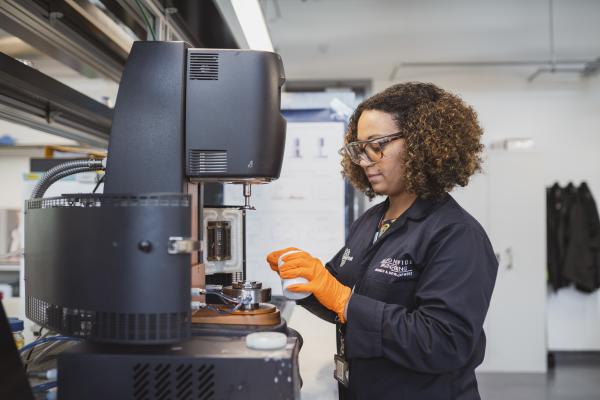The construction industry faces an urgent problem regarding carbon footprint, with concrete accounting for more than 7% of all global CO2 emissions, principally from energy cost in the manufacture of cement.
With an ambitious target to become net carbon neutral by 2038, Greater Manchester is home to a variety of exciting and innovative companies with unique solutions to increase the use of low energy sources.
Concretene is an example of this, a Manchester-based business creating a new solution to reduce embodied carbon in the built environment. Developed in partnership with The University of Manchester’s Graphene Engineering Innovation Centre (GEIC), the company’s innovation is graphene-enhanced admixture that improves the microstructure of concrete, significantly reducing the quantity of cement required for equivalent performance.

Ayla at work
MIDAS speaks to Ayla Mafuta, Research Technician at Concretene to get a glimpse into a day in her working life and to get an insight into what it takes to decarbonise construction!
When I first wake up, I prepare for the day by...
A morning stretch to get me ready for the day and a nice latte made on my espresso machine at home. I usually take the train into Manchester and enjoy a brisk walk from the Victoria Station, during which I listen to some of my favourite podcasts. I’d highly recommend Crime Junkie, an American podcast for true crime enthusiasts and You’re Dead to Me, a BBC comedy podcast about history, since that’s a subject I could have paid more attention to in school.
I work at…
Concretene, a start-up based at the Graphene Engineering and Innovation Centre in The University of Manchester. We focus on decarbonising construction by formulating Concretene, an admixture for concrete applications. This product harnesses the unique properties of graphene to enhance the performance of concrete, reducing the amount of cement required and so also reducing its carbon footprint.
I’m responsible for...
As a Research Technician, I work hands-on in the laboratory to formulate and characterise Concretene. My key responsibilities include optimisation of the process and formulation of Concretene through research as well as monitoring the stability and quality of the product.
A typical day looks like...
My day starts and ends in the laboratory. I start by calibrating our lab equipment and making a batch of Concretene and then performing various QA tests. I liaise with our materials testing lab, who mix the formulation into batches of concrete and carry out performance testing. Then typically, a bit of computer work to upload and analyse data.
Lunch time is shared with numerous other companies in the Graphene Engineering and Innovation Centre, who all are working on applications of graphene or other advanced materials. My afternoons usually involve more research-based work. Bringing out the 2nd generation of Concretene through our GraphEnhance project is quite exciting, as well as our GraphSMART project which focuses on the precast sector and scale-up.
The best part of my day is...
Going home and cooking a nice meal. I enjoy cooking and find it relaxing to wind down after a busy day. I like to cook a variety of foods, including American cuisine like chicken and dumplings, Thai inspired curries and Italian dishes like lasagne. My go-to winter warmer meal is broccoli and cheddar soup with some nice crusty bread.
Do you face any challenges and how do you overcome them?
There are definitely challenges in working to decarbonise construction and formulating a new product with a material we are still learning about. But we have a great technical team and are partnered with some of the best in this field like the nanomaterial hub at The University of Manchester, international design and engineering consultancy Arup, and Canadian graphene supplier Black Swan.
What would someone who wants to break into your industry need to know?
They would need to understand the drivers in the construction industry, while having a curious mind, problem-solving skills, and ability to think out of the box. But they would not necessarily need to be an advanced materials scientist. Our team is made up of people with backgrounds in contracting, finance, media, as well as those doing the nanomaterial science. Innovation doesn’t happen on its own, it works best with a team possessing diverse abilities, so collaboration is also a key factor.
How do you collaborate with the wider manufacturing eco-system?
We work with The University of Manchester on various projects in the Graphene Engineering and Innovation Centre along with key players in the construction industry as we bring our product to market.
Greater Manchester is known as being one of the UK’s most liveable cities – how do you make the most of it?
There are always plenty of things to do in Manchester, and as an American living in Manchester, a lot is still new to me and there’s so much to explore. I’m originally from Pennsylvania and moved to Manchester in 2021 – so my partner and I enjoy trying different restaurants, usually brunch spots and bakeries, along with enjoying a nice walk in the parks and along the canals.
Visit Concretene.co.uk to find out more.

